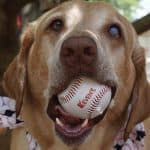The love that you have for your dog is shown in countless ways, from offering treats to tossing a ball outside. Taking care of his health is also part of this unconditional love. With this fact in mind, being aware of Fido’s weight should be high priority. If your pooch is growing a bit pudgy, read these dog dieting guidelines to slim them down to a healthier weight.
- Consult With Your Vet
When Fido appears overweight, start the dieting process with a trip to the veterinarian. Every breed has a weight range that’s unique to the animal’s bone structure. No two diet plans are the same when it comes to canines. The vet can look your pet over and determine the best course of action. If there are any chronic conditions, such as a heart murmur, they will be taken into consideration as a diet plan comes to life.
Without your vet’s assistance, a random diet may not be very effective. In fact, it can be outright dangerous to the dog’s health. All health issues must be examined and matched to a diet for a positive outcome.
- Understand the Health Implications
Some households might be wary about starting their dog on a diet. The effort is certainly substantial. However, consider the health implications if the dog remains overweight. Similar to human beings, dogs can suffer from diabetes, heart disease, high blood pressure and even cancer. It’s worth the effort to put the dog on a healthy diet. Some chronic conditions can actually be stopped in their tracks with just a few pounds shed. Fido will have newfound energy and, possibly, a longer life with a leaner body. If you have more than one dog at home, encouraging every animal to be healthier is a positive goal.
- Choose a Well-Rounded Food
A big part of dieting for dogs is choosing the proper food. Common brands are often full of basic nutrition, but the fat content remains high. Ask your vet about recommended foods. There are many science-based foods available online or at the vet, some being prescription-only.
Diet foods look just like simple kibble but it’s their ingredients that differ. They’ll have less fat, more nutrients and leaner meats. Each food is often designed for certain conditions too, from digestive health to urinary-tract care. Regardless of the food’s design, a low fat type is almost always the best for overweight dogs.
- Incorporate the Food into Daily Life
Dogs can be amazingly picky when it comes to their food. Avoid swapping the old and new food all at once. The pooch needs time to get used to the new taste. Slowly add the new food into each meal. As each day passes, continue to add new food and remove the old food until the bowl is full of the diet food exclusively. Most dogs acclimate to the food in this manner.
This strategy works well for both hard and soft foods. Simply keep up with the dog’s normal routine so that they don’t suspect a change to their food. It becomes the normal taste over time.
- Slow Down the Eating Frenzy
One of the main reasons why dogs tend to beg for food is the speed at which they eat. Dogs consume their food almost like a vacuum. The key to dieting for dogs is slowing them down. Consider a puzzle feeder where the dog must eat at a slower rate because the kibble is difficult to reach. These feeders don’t frustrate dogs. In fact, it stimulates their minds to solve the puzzle as they eat. As a result, they’ll feel fuller at a faster rate than before. Dogs’ digestive systems react in the same manner as humans; that full sensation takes time to develop in the mind.
- Refrain from Treat Overload
Walk into any pet-food store, and an entire aisle is dedicated to treats. Be careful with these dog-approved treats because they can derail a diet. Consider tiny treats, such as training varieties. They often have one or two calories per treat, which has minimal impact on the diet. Dogs shouldn’t rely on food treats all the time either. Remember that treats in the form of pats on the head or hugs are also effective. Mix up the type of treats each day so that the dog doesn’t expect one specific thing. Fewer food treats allows the diet food to nourish the dog and help with weight loss.
- Stop the Human-Food Train
Pet owners often have the habit of offering human food to their canine counterparts. Ideally, don’t give your dog any human food during the dieting period. Their dog food should be carefully measured out for their weight, which gives them all the nutrients necessary. They may appear to be hungry, but that’s not the case.
If you’re concerned about your dog having enough food, discuss portions with your vet. The professionals might suggest more or less of the dog’s food so that they’re satisfied each day. Supplementing their diet with human food will negate the diet’s efficacy and human food is simply too rich for most dogs’ systems. The only exceptions might be vegetables and fruits approved by your vet.
- Increase a Workout’s Impact on Weight
Most families walk their dogs each day for potty purposes. Marking territory and walking at a slow speed are hallmarks of these outings. Consider a few alterations to the walk so that your pooch loses more weight.
Encourage a faster gait by walking fast on your own. Allow the dog to stop and smell things at certain points, but keep the pace up otherwise. Always keep the dog’s health and well-being in mind during these outings. If you have an older dog, for example, the walks may not have too much intensity. Younger dogs can certainly take on more strenuous walks or even runs.
- Add in Fun Distractions
Your dog doesn’t have to solely rely on walks to increase their activity. Don’t forget that fun distractions are perfect ways to keep up with weight loss. Head out to the park, throw a ball and enjoy the fetching action. Even a relaxing walk at the beach is a great way to stay in shape as a family. These distractions keep your dog busy and unaware of the lack of treats. It’s the activity that’s the excitement! Weight loss is just a natural side effect of these excursions. Try to take your dog out several times a week for the most benefit.
- Update Loved Ones on Diet Parameters
Doggie diets can certainly backfire when visitors and other loved ones don’t know the household rules. If you have anyone visiting for an extended period of time, discuss the dog’s diet parameters with them. You might mention certain treats that are approved by the vet during the diet instead of fatty alternatives. By letting everyone know that the dog shouldn’t eat unapproved items, the diet can stay on track. This strategy also prevents possible sickness if the dog overeats. If multiple people in the household are slipping the dog some treats, the diet and its healthy outcome can be jeopardized.
Need another way to keep your fur baby active? Bring them to Pawderosa Ranch for a fun-filled day of exercise and playtime with other pups. Schedule a playdate today!




